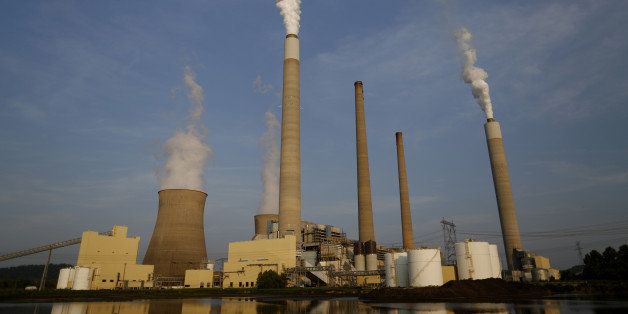
This story was originally published by The Guardian and is reproduced here as part of the Climate Desk collaboration.
To Washington insiders he is Dr Evil: the hidden orchestrator of industry campaigns against the Humane Society, Mothers against Drunk Driving, and other seemingly uncontroversial groups.
Now Richard Berman, a one-time lobbyist turned industry strategist, has zeroed in on another target: Barack Obama’s new power plant rules.
Over the last year, Berman has secretly routed funding for at least 16 studies and launched at least five front groups attacking Environmental Protection Agency rules cutting carbon dioxide from power plants, the Guardian has learned.
The rules, the centre-piece of Obama’s climate agenda, are due to be finalised in mid-summer. They have come under sustained assault from industry and Republican-controlled Congress – and Berman is right at the heart of it.
The attacks may be gaining traction. The EPA chief, Gina McCarthy, suggested in a speech this week the rules were likely to change in response to public comment.
From the offices of Berman’s PR firm in Washington, at least five new front groups have launched attack ads against the EPA, environmental groups, fishermen and sportsmen, and green building organisations. The groups all use Berman’s address.
Meanwhile, the Employment Policies Institute, a tax-exempt organisation headed by Berman and operating out of his office according to tax filings, funded a series of reports by an ultra-conservative thinktank, the Beacon Hill Institute.
The reports, claiming the power plant rules would lead to rolling blackouts, send electricity prices skyrocketing, and devastate local economies, are being published in 16 states by a network of pro-corporate and ultra-conservative thinktanks.
All of the reports were funded by EPI, according to Suffolk University, the host institution for Beacon Hill. Suffolk released a list of such grants.
Berman did not respond to requests for comment. However, a spokesman, Jordan Bruneau, confirmed that EPI was funding the analyses of the EPA regulations.
“Currently IPA is working with economists to determine the effects of certain EPA regulations on particular states,” he said in an email. He said the research was entirely funded by foundations but refused to identify those funders.
Those familiar with Berman say he is a prime example of a new industry strategy of bypassing traditional lobbying organisations, and using thinktanks, foundations, experts, and social media to shape the public conversation and – ultimately – legislation.
“Richard Berman is very well known for certain front groups and for taking money from anonymous sources to fund aggressive campaigns in the interests of the individuals and the corporations who fund him with the understanding that that funding will be kept secret,” said Nick Surgey, research director of the Center for Media and Democracy.
Indeed, Berman claims his ability to hide the funding sources for such campaigns as a particular expertise.
“People always ask me one question all the time: ‘How do I know that I won’t be found out as a supporter of what you’re doing?’” Berman told a conference of energy executives last year. The talk was secretly recorded and leaked to the New York Times.
“We run all of this stuff through non-profit organisations that are insulated from having to disclose donors. There is total anonymity. People don’t know who supports us,” Berman told the energy executives.
He claimed at the time to have already collected six-figure sums from some of the companies in the room – and solicited $3m more to defeat opponents of fracking.
On such a scale, the funding for an economic study taking down the EPA rules appears relatively economical. Beacon Hill received $41,500 from the Employment Policies Institute for a study of the EPA rules, according to the grants list maintained by Suffolk University.
The funds were allocated to produce reports on the impact of the EPA rules in 16 states including: Iowa, Minnesota, Mississippi, Nevada, New Mexico, North Carolina, Tennessee, Wisconsin, South Carolina, Virginia, Louisiana, Rhode Island, Washington Ohio, Alaska and Utah, a spokesman for Suffolk University said.
The university spokesman said in an email that the grants followed university protocol. “Suffolk does not accept research funds from unknown sources,” the spokesman said in an email.
Beacon Hill is associated with a network of ultra-conservative groups working with the American Legislative Exchange Council and funded by patrons of anti-government causes such as the Koch brothers and Searle Freedom Trust.
Its director, David Tuerck, appears on the roster of experts at the Heartland Institute, which adopts an extreme-sceptic position on the existence of human-caused climate change. Tuerck has also featured as a keynote speaker at Heartland’s climate conferences.
He told the Guardian he had mixed views on climate change. “I am not certain that those emissions are significant enough to offset other factor changing the climate,” he said. But he was categorical that efforts to cut emissions were “a waste of time”.
“We are just heaping unnecessary costs on the American economy,” he said. “It’s as obvious as the nose on anybody’s face these EPA regulations are inevitably going to drive up electricity rates.”
Over the years, BHI has been accused of using discredited economic models to exaggerate the costs and downplay the benefits of government regulations.
“I think what is dangerous about BHI is that on the face of it appears to be an academic institute producing independent reports but when you peel back the first layer of the onion you find that Beacon Hill often skews reports in favour of their funders,” Surgey said.
In 2013, Suffolk University publicly repudiated Beacon Hill after the Guardian reported the organisation told prospective funders its studies could undermine a regional climate change initiative. The claim did not follow Suffolk University rules for grant proposals, the university said.
Jay Duffy, a legal fellow at the Clean Air Task Force, said the current BHI analysis of the EPA rules did not meet the usual academic standards. “BHI’s interpretation of EPA’s analysis just doesn’t hold up,” he said. “BHI has skewed timelines, underestimated the social cost of carbon, and overestimated the effect on electricity prices. As a result, their study badly inflates the costs and minimises the benefits of EPA’s draft rules.”
BHI defended the study. “Our costs are within the broad range of costs that the EPA produces,” said Paul Bachman, who directly oversaw the study. “It’s just that we don’t include – we exclude – what they call the co-benefits of the proposal.”
Berman’s other forays into the environmental arena this year have been hard-hitting.
One prime example was the Environmental Policy Alliance – a mirror image of the government agency – which, according to the website, is “devoted to uncovering the funding and hidden agendas behind environmental activist groups and exploring the intersection between activists and government agencies”.
The group oversees four projects aimed at discrediting the government agency and environmental and conservation groups.
In a full page ad in Politico last year, one of the projects, EPA Facts, asked: “What would you call a radical organisation that threatens to shut down 25% of our electrical grid?” The ad crossed off responses including anarchist, terrorist and militia before coming to Obama’s EPA.
Another Berman creation Big Green Radicals claims environmental groups are funded by Russian oil interests close to Vladimir Putin, put up billboards on the Pennsylvania turnpike attacking Lady Gaga, Robert Redford and other celebrities who oppose fracking, and sent a poison Valentine to the fossil fuel divestment campaign.
Green Decoys takes on sportsmen and fishermen who support the power plant rules. Leed Exposed opposes green building codes.
The outrageous claims are a key part of the strategy, Berman has claimed. “Berman and Company isn’t your average PR firm,” his company website said. “We don’t just change the debate. If necessary, we start the debate.”
